Using Apocalypse World to Outline and Draft Your Own RPG
Here in Part 7, I’m setting aside some time for a good old straightforward Q&A.
I’ve gotten enough questions, and they’re challenging enough, that I’m taking them in rounds. Here’s round 2!
This article was made possible by the generous support of my patrons. Please consider joining them by supporting me on Patreon.
Let’s get back into it!
Q:
Vincent, what’s Blorb? What are its principles? What’s inspiring you about it?
Many people on several platforms
Blorb is a disciplined, principled approach to old-school GMing. It emphasizes the reality of the game world, and provides fruitful constraints on the GM’s improvisation in play.
You can read its principles here: https://idiomdrottning.org/blorb-principles
It may seem like a strange thing for me, personally, of all people, to be into! I’ve heard that it is. But I see it as a very strong system of support for GMing in play, not a set of restrictions to labor under, and at the same time a provocative spec for design.
Take a look at the brilliant little analog NPC AI built into Sandra Snan’s Instant Blorb one-page (pdf link), for instance. As GM, I can rely on it, like I can rely on well-made PbtA moves, as footing for play. I don’t have to interrupt my train of thought midplay to weigh competing prep-vs-GMing priorities — NPC character integrity vs pacing vs challenge vs etc. — or to think through NPC relations. They’re all right there for me and as GM I can relax and, thoughtfully, attentively, watch them happen.
Q:
Is PbtA a system or a philosophy, indeed? It does not matter for me, but there is a bloody war in the Spanish pbta community about the use of both words.
@OtherCynicalGuy
Before I answer, let me tell you, whenever PbtA games reach a new audience, this is one of the debates they have. It’s usually bloody! My heart goes out to the casualties on both sides.
If you ask me, PbtA is a school of design, like an artistic or literary movement. It’s like Surrealism, Romanticism, or Newgrass music. It’s not defined by a system OR by a single coherent philosophy.
Instead it’s defined by a body of work, always growing and changing, always open to debate and reinterpretation. Each new PbtA game casts light on all the PbtA games that came before, and changes the field for all the PbtA games that might come after.
I think it’s better to hold up two different PbtA games and say “how are these the same? How are they different?” than to hold up any single PbtA game and say “is this truly PbtA?”
You see, I love all PbtA games, but the ones I find the most striking are the ones that depart from PbtA conventions, systemically and philosophically, not the ones that adhere to them. That’s why there’s no PbtA manifesto.
That’s why I talk about how you can use PbtA, not what PbtA is. I’m not interested in “what PbtA is.” I’m always interested to see what people use PbtA to make. If it’s offbeat, experimental, breaks from the form, contradicts earlier games, opposes Apocalypse World outright – great!
PbtA isn’t a tool for limiting what games can do, it’s a tool for exploring what games might do. I’m opposed to the creation of any PbtA orthodoxies: “a PbtA game must have x, y, and z.”
Make your game how you want it. If PbtA inspired you, then you’re allowed to call it PbtA, and nobody can say you’re not.
And like, this isn’t just definitional wrangling. It’s our policy. Lots of people think that PbtA should mean specific things, but you don’t need their permission to put the PbtA logo on your game! You need Meg’s and mine.
Other definitions are fine for personal use, but when it comes down to it, this is the one that goes with the PbtA logo.
(Assembled from my replies on Twitter.)
Q:
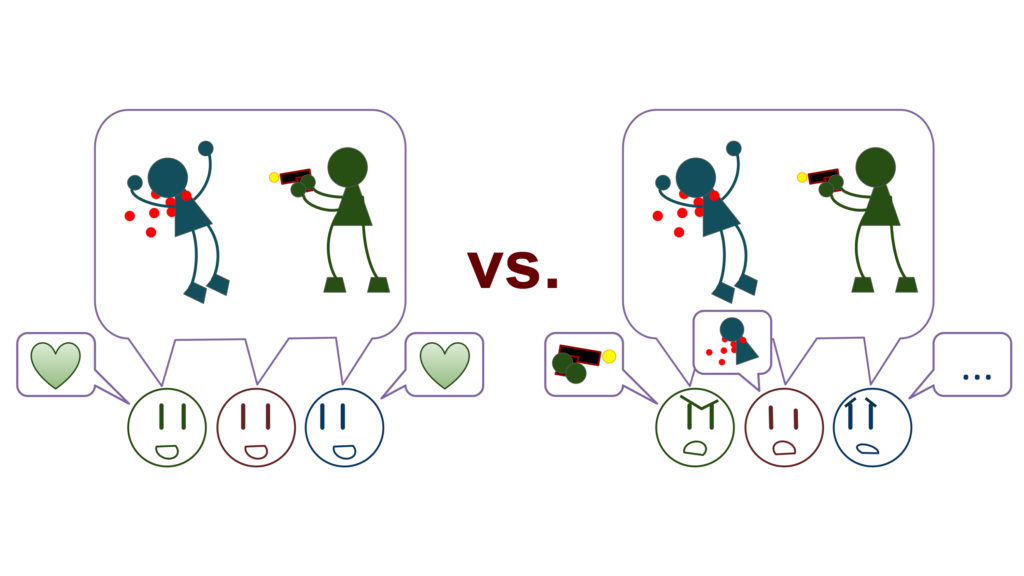
You wrote: “When your character escalates a conflict, you give the other player the choice. When somebody else escalates a conflict against your character, they give you the choice.” What choice is being given? Is it the choice about what to do next? I don’t understand how that applies to this situation you’re posing, where one character has inflicted harm on another character. What is “the choice” and how does it preserve harmony between the players?
Vian
There are good choice to make in the aftermath of harm too, but really the situation I’m talking about is the lead-up to harm. When my character makes the decision to escalate conflict against yours, to take the next step toward harming yours, what choices do the rules give you before it happens? How do they let you prepare for it, guard against it, forestall it, or rush to meet it?
It’s the explicit choice you make in going aggro, for instance: my character goes aggro on yours, so you decide whether your character backs down or fights back. Or the explicit choice in seducing or manipulating: my character wants yours to do something they haven’t agreed to, so I offer you the carrot and/or the stick, and you choose — not me! — whether your character does it or not.
These choices preserve harmony between us as players by making sure that both of our interests are represented in the next moments of play. Compare with games where my character goes aggro on yours, I roll to hit, I roll damage — and you never had a choice how to engage. In those games, when the dice are on my side, I impose my escalation on you and you don’t have a negotiating voice.
Now you’re right, in the aftermath of harm, there isn’t a single move that gives you an explicit choice. You do just get to decide how to respond. The most I can say about that is, because there are no mechanical penalties associated with harm, I haven’t actually put you into a weakened mechanical position.
…That is, unless I’ve inflicted the ultimate harm, of course. Then you get to make the move for when your life becomes untenable, and you have such choices.
Q:
People talk about pbta as genre simulation, but a lot of fitd games have very specific and unique settings (ex. Duskvol, the Wildsea, Band of Blades). Is there a reason for this difference?
@billtherad
Well, huh! I bet there’s a very good reason but I don’t happen to know what it is.
In Apocalypse World etc, threats work the way they do because of the way NPCs’ reactions are designed into the PCs’ moves. It’s one system across the player/MC divide, or if you prefer, two systems in tuned tension. If you take up slack in one system, you have to give slack in the other.
My bet is that it’s the same in Blades in the Dark etc: the relatively detailed settings provide exactly the tension required by the structure of the relationship of the resolution rules to the game world.
Beyond that, I’d just be guessing!
Elliot says: Yeah, that checks out. There’s a cycle of FitD gameplay that’s the consequences of your actions, and that cycle needs formal, detailed groups and characters to exist to deliver them.
Q:
“Fiction first” is for me a solid guideline when thinking of #PbtA moves. That means always having fictional content trigger the move. But what can we consider to break from this guideline in some cases? What do we lose and what do we gain?
@jogadorsonhador
Look out! I have beef.
I don’t know where the idea of always having fictional content trigger the move came from. I’ve never espoused or recommended it as a guideline. It’s not in Apocalypse World — Apocalypse World just says that you can’t get the effects of taking action without actually taking the action, and you can’t actually take the action without getting the effects of it. And then Apocalypse World goes on to include like a million moves without any fictional triggers at all, and to explicitly talk about moves without fictional triggers in its chapter about how moves work.
Some other game must have done it that way. I don’t know which, honestly! It came as an idea into PbtA pretty early, so Dungeon World? Monster of the Week? Monsterhearts? Or was it just in the conversation for some reason, not, in fact, in any of those early games?
ANYWAY, the upshot is that to me, moves where fictional content triggers the move are groovy and fine, but a minority of moves work that way. So my answer to your question about when we can break from the guideline is, like, all the time, seriously whenever we want.
What we gain and lose is, we gain the ability to create literally any other kind of move, and we lose nothing important because the moves that should be triggered by fictional content, still should.
Here’s an example. In Murderous Ghosts, one of the moves is “what about the ghost still seems most human to you?” It’s imposed on you under certain mechanical circumstances, not by any particular fictional content. Trying to attach a fictional trigger to that move would mess it up completely, if you could even figure out a way to do it without redesigning the whole game.
In MF0: Firebrands, all* the moves have the same trigger: “on your turn, choose one.” That’s how they’re designed to work, so they work great. Playing the game, it’d never even occur to you that they might have had fictional triggers instead, let alone that they should have had. They shouldn’t!
* Or basically all. There might be an exception or two, I didn’t check.
So yep, that’s my beef. I don’t understand how it came to be a guideline, I don’t happen to know any games that follow it, certainly not any of the games I’ve worked on, and I wouldn’t recommend it.
(If you’re interested, if you haven’t seen it, I wrote more about the subject, sans beef, back in Part 5.)
Q:
I remember in some interview about AW you and Meguey were talking about reading up on apocalypse fiction as research, would be cool to hear more of your thoughts on that. One line that stuck with me went something like “the secret to AW is that the apocalypse is now”
@proton_31
Content warning: brief mentions of cannibalism, infanticide, misogyny, and rape, plus the f-word.
Oh yeah! I was talking about Cormac McCarthy’s The Road.
In The Road, Cormac McCarthy wasn’t saying that in the aftermath of nuclear war or whatever, realistically, some men would enslave and impregnate women just to eat their children, and other men would have to run and fight and hide to protect their own children from them. He was saying that, in a hyperbolized metaphorical sense, right now, in the world around him, he sees men enslaving and impregnating women just to eat their children, and we should fucking look out.
Fury Road isn’t saying that in the future, realistically, as a matter of speculation or level-headed futurism, a grotesque water tyrant will come to imprison and enslave women in a narcissistic effort to redeem his own mutated genes, it’s saying that in a hyperbolized metaphorical sense, right now, in the world around is, this is what’s happening.
“Who killed the world?” means “who is killing the world?”
So, yeah, the secret to Apocalypse World is, we’re not asking, in a realistic post-apocalyptic future, what will real people make of their world?
We’re asking, right now, in the world around us, old ways of doing things are in ruins. In a hyperbolized metaphorical sense, the world is ours to remake. What will we make of it?
Meg here: When I say on the back of the book “this is what we’ve got, yes, What are you going to make of it?” I’m not just talking about in the fiction of the game you might play. I’m asking you what you are going to do to address the actual and ongoing apocalypse at hand. Choose one. There’s many to pick from!
That hyperbolized metaphor Vincent talked about above is all true, and also really and directly present; in the particulars of The Road and Fury Road, the concerted effort to strip reproductive freedoms and access to safe medical care from women in the US. You don’t need to look very far afield or very deep into metaphor to see what’s happening.
The world is on fire. What are you going to do, with the vision and insight and access and tools you have, to make the the world a better place? To help combat the pressures of the world’s psychic maelstrom on everyone around you, and the ways they have metastasized in some places to create threats all over the map? To do it, do it!
Q:
Does the specificity of moves determine a game’s replayability? Eg, a game with highly themed and unique moves containing listed outcomes is very appealing for marketability, but can people play it more than a few times?
@DThaumavore
Does the specificity of moves determine a game’s replayability? I admit I don’t know, but I don’t think so.
When I’m thinking about this concern in my own work, I break it out into a whole array of design questions.
Replability:
- Do I intend this game for single-session play or multi-session play? If the latter, how do I win the players over into playing the next session?
- Do I intend this game to come to a definite end after just a few sessions, to come to an end when the players want it to, or to play on indefinitely?
- After the game’s ended, do I intend the players to play it again in the same group, or do I expect the group to be done with the game?
- After the game’s ended, do I intend any of its players to play it again with a different group, or do I expect them as players to be done with the game?
- How much planning and commitment does this game require? Does it offer enough back to the group to make good on their investment?
- Or how about this one: Do I care whether people replay this game at all, or do I hope that they play it once, and go on to check out my other games instead?
Specificity:
- What’s the entire range of actions and situations that I intend this game to cover? Everything? A wide range, but not everything? A narrow range?
- For actions and situations outside of its intended range, how does the game handle them? By shunting them into a general catch-all? By handwaving them? By disallowing them? By leaving them unaddressed?
- What’s the game’s model for actions and situations within its range? Humanistic? Elemental? Cinematic? Philosophical? Psychological? Literary? Poetic? Magickal? Or what?
For any given individual action or situation within its range:
- Should this be its own move? Should it be an option in a more general move? Should it be a category of more specific moves?
- Should this be a move or option that every character has access to? Many characters, but not every one? Only one character? Only characters in a particular circumstance? Or who?
- Should the game set this action or situation on equal footing with others? Should it play it up? Play it down? Highlight it? Put it behind warning tape? Or what?
Marketing:
- Is this game’s audience people who’ve played my other games, people who’ve played other games like mine, people who’ve played ttrpgs, people who like D&D, people who’ve played D&D and want something the same but different, people who’ve never roleplayed?
- At their first encounter with these moves, do I want the audience to feel comfortable or unsettled? Do I want them to feel like an insider with previous experience to build on, or an outsider standing at a newly-opened door?
- Do I want these moves to cater to the audience’s expectations, ease the audience into new ways of thinking, or challenge the audience to keep up?
- Am I marketing playing this game, GMing this game, reading this game, discussing this game, or just buying this game? In what order of priority?
- Am I marketing this particular game, a series of games, all my games, this approach to designing games, indie games, or roleplaying games (as opposed to other leisure activities)? In what order of priority?
- What obstacles stand between the game’s audience now and their sitting down to play it? How does it help them navigate these obstacles? Which obstacles does it leave for them to overcome without its help?
So I guess here’s my caution: taking these questions and summing them up as a principle, like “specificity of moves is good for marketing but reduces replayability,” really flattens out a complex body of concerns.
Even if it’s true in general — which I have no idea, we’d have to conduct real research to find out — no game exists in general. Every game exists in its own unique, real position in the overlap between its creator’s intentions and its audience’s needs.
In other words, even if it’s true, it doesn’t matter! Every game would be a special case.
Q:
PbtA motto “Play to find out what happens” seems quite far from enabling mystery stories where players play to find out a pre-existing mystery. What have been the attempts to reconcile this apparent contradiction? And your take on it?
@LamSonLeoc
Mysteries are difficult!
Apocalypse World’s conflict model is suited to crime dramas over mysteries, if you see what I mean. Dangerous, troubling things happen, and you might not know why or who did them, but the game’s designed to make it as clear as possible as quickly as possible, to get on to the meat of finding out what you’re going to do about it.
Most PbtA games have stuck with this conflict model. I could name several that break away, of course, but none of them are mystery games. Murderous Ghosts is the closest I can think of, and it’s designed intentionally to prevent you from solving the mystery!
My take is, if you want to make a PbtA mystery-solving game, you can, but you’ll need to break from Apocalypse World’s conflict model and build a good mystery model instead.
You know, I wonder if Benoit Blanc’s Gravity’s Rainbow take could provide a good starting place for a mystery model. “I observe the facts without biases of the head or heart. I determine the arc’s path, stroll leisurely to its terminus and the truth falls at my feet.” What do you think?
Q:
Which are the limits of PbtA? Which are the blind spots or dark areas that PbtA design philosophy hinders shedding light upon?
@pedro_2eeter
Well, I know one big blind spot for certain.
Here’s a picture of, yknow, roleplaying:
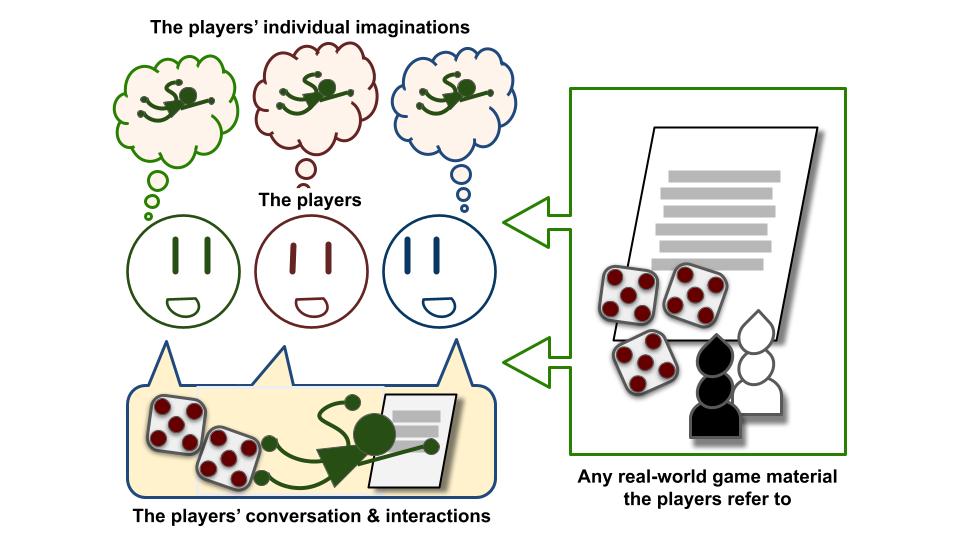
It shows the players, each with their own individual imagination. It shows the real-world game material they refer to in play. And it shows that their conversation and interactions include both the fictional things and the real ones.
(The little flying figure, by the way, is a reference to Part 4 of this series. Think of it as representing a character in action somewhere along their trajectory, a visual reminder of the whole arc of play.)
Here’s a picture of what PbtA does*:
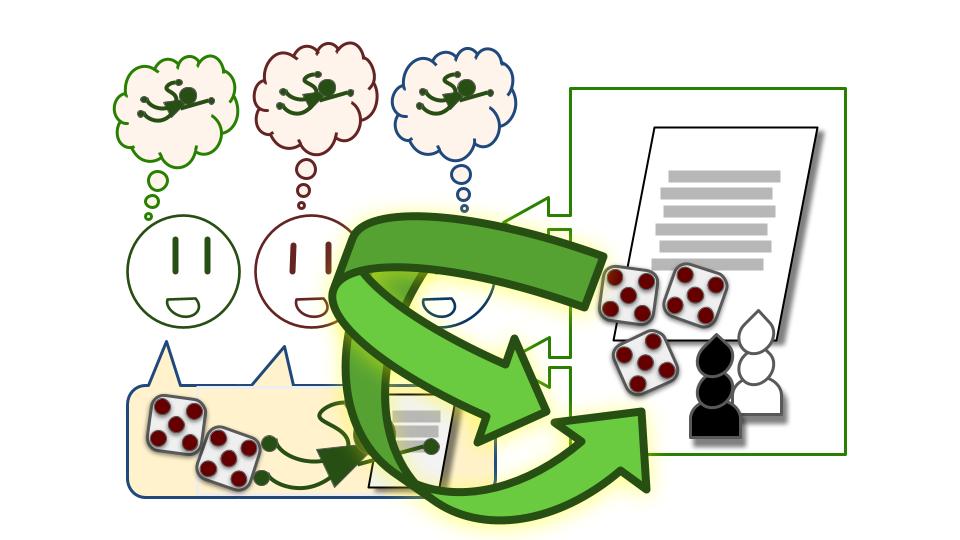
PbtA focuses on the players’ interactions and their relationship with the real-world play material. Apocalypse World’s rules, and PbtA has followed along the same lines, tell the players what to do in the real world (“mark experience,” “roll+Hard,” “choose from this list”) and what to say to each other (“ask the MC 1 of the following questions,” “tell the other player what you’re doing and ask how their character takes it.”)
The foundation of Apocalypse World’s rules are tell and ask.
Here’s a picture of what PbtA doesn’t do*:
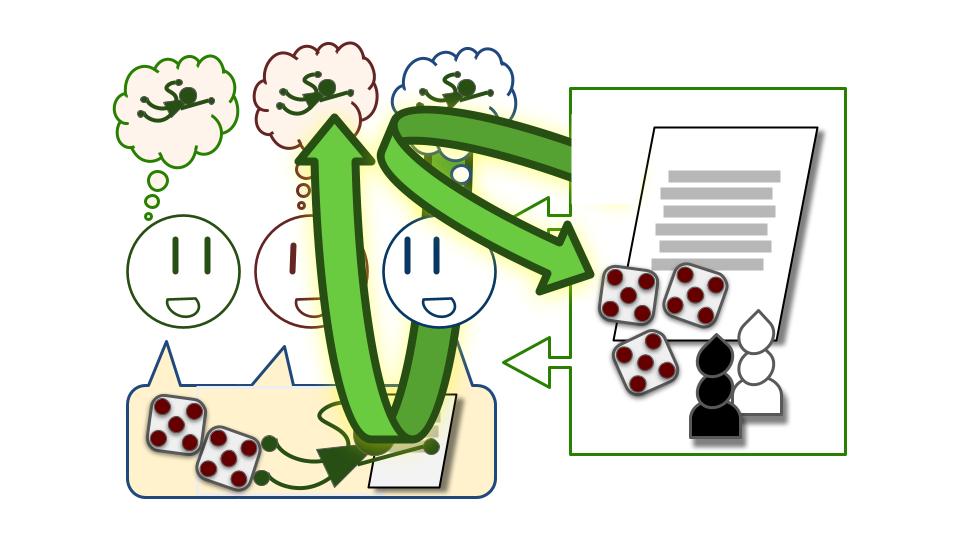
PbtA turns a blind eye, almost completely, to what the players are imagining. It doesn’t treat your vision as real, except after you’ve communicated it, and only insofar as the other players have affirmed it.
Even the things the GM imagines, which many other games treat as truth rock-solid, Apocalypse World reduces them in so many words to daydreams and imagery, ephemeral, unreliable, untrue until they’re brought into play by communication.
* So far. This isn’t definitional in any way; it’s a matter of history, convention, fashion, and design sensibilities.
I think that going back and applying PbtA’s insights to play centered on the players’ imaginations, over their conversation, could produce some really breathtaking games.
Q:
What is your advice to create one-shot sessions (just a few hours, let’s say 3-5, for ttrpg events, demos…) to get a decent narrative arc and ending, but without losing the essence of “play to find out what happens” and so on?
@AryaneMoon
Back when I used to run a lot of Apocalypse World con games, 2013-2015 or so, here’s how I’d do it.
Start
Limit your selection of playbooks. I used to go with the battlebabe, the brainer, the chopper, the gunlugger, the savvyhead, the skinner, and one or two of the extended playbooks.
Start playing without making characters. Get one player to commit to their playbook choice and lead out. Everybody else can listen and look through their playbooks.
The volunteer’s in a bad spot. Cut off, pinned down or captured. Have a spot in mind that you can describe in detail. Use Dremmer for your immediate antagonist, with, um, Jackabacka, Mice, Dustwich, and maybe Plover or somebody as their gang.
Push reading a person or reading a situation onto your volunteer, depending on the spot you’ve put them in. Want to read Dremmer? I think you should. Wait! What’s your name? Choose one. You can choose your looks in a second. To read a person, you have to choose your stats. Choose now. Good choice! Reading a person means rolling+sharp, so roll two dice and add your sharp.
Now you’re playing.
When they’re done reading Dremmer, turn to the other players. Make sure they’ve chosen playbooks. They’re trying to find their friend, who they know is in a bad spot. I guess you want to read the situation, right? You both can. What are your names? Choose your stats and roll for it. Hey, first volunteer, while they’re doing this, why don’t you choose looks, and check this out, you get to choose a couple of these playbook moves, so look them over too…
So you have them create their characters in early play, as they need each section. Ignore Hx for now.
Session Break
Play for about 60-80 minutes, then…
What I’d like to do is play out 2, maybe 3 “sessions” in this session, I’d say. So let’s call this the end of session 1. We have some quick end-of-session stuff to do, then we can take 5, then come back for session 2.
Oh actually wait! I forgot, let’s do Hx, we need to do that first.
Lead them through Hx. Have them highlight stats, and I’d always give them a few xp to make up for any they’d missed during the first session, plus a couple more — I wanted them to improve at least once during the game.
Then lead them through the end of session stuff and take a few minutes’ break.
During the break, start a threat map, so that as people come back, you’re at the table working on it. Hey check this out, I want to show you what it looks like from the GM’s side. This is my threat map, here’s you all at the center, here’s Dremmer. You don’t know this but here’s the death ray satellite that Dremmer’s got Jackabacka working on to figure out the controls… Or whatever apocalyptica you’ve dreamed up.
Once everybody’s back, do beginning of session moves and you’re back into the game.
End
Like I say, I’d shoot for 3 mini-sessions.
I’d play as hard as I could. It was often not as hard as I would’ve preferred, because of con schedules, jet lag, playing with strangers, my own natural shyness… But I always tried to give them my best.
There’s not much you can do to get a satisfying ending. Apocalypse World is designed for more than 3 quick sessions, after all. Most of the time, I’d try for a cliffhanger instead. Cliffhangers are almost as satisfying as endings, and much easier to get in a 3-5 hour con slot.
So that’s what I’d do! Make characters during early play, not before; play more than one session per session; give spoilers at the session breaks; and try for a cliffhanger instead of an ending.
More questions?
Please ask! It’ll be my pleasure to answer.
Thanks, everyone!
Past Installments:
- Back in Part 1, I laid out Apocalypse World’s philosophy and foundation, described the fit and purpose of its systems, and talked about which features are central to its workings and which aren’t.
- Then in Part 2, I walked through the beginnings of taking Apocalypse World’s parts and using them as the basis for a whole new game.
- In Part 3, I dived back into Apocalypse World’s basic moves. I went through them one by one to talk about how and why they work the way they do.
- In Part 4, I talked about playbooks, by request. What are they, do you want them in your game, and what are the alternatives?
- In Part 5, I took a quick aside to talk about some different ways that moves can fit into the conversation of play.
- In Part 6, I used an Ursula K. LeGuin quote — you probably already know the one! — as an outline for alternative models to Apocalypse World’s model of conflict.
- Q&A Round 1.
Next Installments:
- Q&A Round 3: the Lightning Round! Q&A Round 4: the Final Round!
- In Part 8, I share my six best, most reliable tricks for drafting interesting moves.
- In Part 9, I lay some groundwork for the idea of underlying models by pointing out a crucial feature of Apocalypse World.
- In Part 10, I develop the idea of underlying models further, with 2 solid examples and 1 tentative one.
- In Part 11, I explore a few of the dice systems we’ve used in our PbtA games.
- In Part 12, I point out a detail in Apocalypse World’s playbook moves that you might have missed.
Reminder: The Goal is to Create a Playable Outline
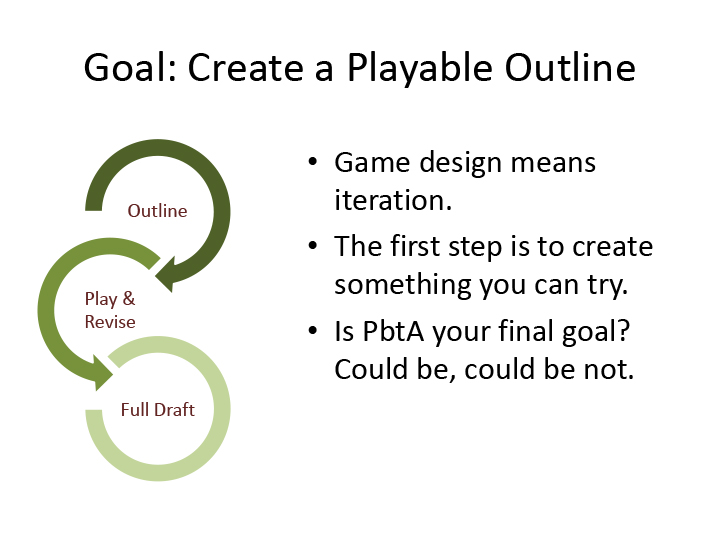

Clarity says:
It probably doesn’t matter to know, but to the question of the history of “fiction-first”: Dungeon World has a GM principle of “begin and end with the fiction”, which I believe is where it started.
Vincent Baker says:
Aha, that makes sense. Thanks!
Clarity says:
Also, very surprised to learn that I’ve been making a Blorb game this whole time! Good to have something preexisting to point to!
Vincent Baker says:
Oh very cool!
Teori-innblikk # 11 – ropeblogi says:
[…] https://lumpley.games/2021/05/31/powered-by-the-apocalypse-part-7-qa-round-2/, av Vincent Baker, om blorb, definisjonen til PBTA og andre kommentarer. […]
Timothy "TekLazar" Kaser says:
I am confused on what exactly you mean in the section of “what PBTA doesn’t do (so far)”
Is what you meant is that the MCs (or another player’s) imagination is not the universal truth? So they all should try to go along with what is said and not the other way around?
I guess I am confused because the opposite just seems like it is clearing up misunderstandings that may occur. Like
“he’s a chicken”
“like an actual chicken?”
“Sorry, I meant he is a coward”
Although it would be quite interesting if instead the MC was instead told to do,
“He’s a chicken”
“like an actual chicken?”
“…Yes… you are absolutely correct.”
Where the second perceived imagination, is the one that is correct. Is something like this what you mean by, “PBTA doesn’t do that (so far)”?
Rollenspiel mit Drama Queens - Plotbunny Games says:
[…] darin im Abschnitt „Permissions & Expectations Again“ und führt sie in der dritten Frage in diesem Blogpost so näher aus (aus den beiden Posts stammt auch die Grafik im nächsten […]
The OSR Onion – The Dododecahedron says:
[…] things, the dice and stats and so on, to give momentum to the fictional things.” Later, in a Q&A post, he revisits this idea: “PbtA focuses on the players’ interactions and their relationship […]